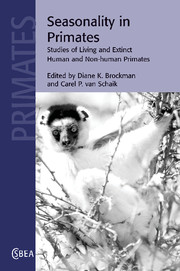Book contents
- Frontmatter
- Contents
- List of contributors
- Preface
- Part I Introduction
- Part II Seasonal habitats
- Part III Seasonality and behavioral ecology
- Part IV Seasonality, reproduction, and social organization
- 10 Seasonality and reproductive function
- 11 Seasonality of primate births in relation to climate
- 12 Energetic responses to food availability in the great apes: implications for hominin evolution
- 13 Human birth seasonality
- 14 Seasonality, social organization, and sexual dimorphism in primates
- Part V Seasonality and community ecology
- Part VI Seasonality and human evolution
- Index
- References
13 - Human birth seasonality
Published online by Cambridge University Press: 10 August 2009
- Frontmatter
- Contents
- List of contributors
- Preface
- Part I Introduction
- Part II Seasonal habitats
- Part III Seasonality and behavioral ecology
- Part IV Seasonality, reproduction, and social organization
- 10 Seasonality and reproductive function
- 11 Seasonality of primate births in relation to climate
- 12 Energetic responses to food availability in the great apes: implications for hominin evolution
- 13 Human birth seasonality
- 14 Seasonality, social organization, and sexual dimorphism in primates
- Part V Seasonality and community ecology
- Part VI Seasonality and human evolution
- Index
- References
Summary
Introduction
Seasonal variation in the frequency of births is a nearly universal phenomenon in human populations (Cowgill 1965; Lam & Miron 1991; Bronson 1995). Indeed, the absence of birth seasonality in any particular population can be considered a remarkable observation (Brewis et al. 1996; Pascual et al. 2000). However, the broad prevalence of human birth seasonality does not imply simple causation. Several mechanisms have been proposed to account for the seasonality of births in different specific cases, and most investigators acknowledge that multiple causes are almost certainly involved. Nevertheless, some of the causes of human birth seasonality are likely to have deeper roots in our biology as hominoid primates than others. It will not be possible to review all the hypotheses that have been put forth or to survey the extensive empirical literature on human birth seasonality in this chapter. Rather, the purpose of this chapter is to discuss some of the major hypothesized causes of human birth seasonality in a way that highlights their relevance to the evolutionary ecology of our species and their relationship to the ecology of other primates.
The major hypotheses regarding human birth seasonality can be grouped under three headings: seasonality due to social factors that influence the frequency of intercourse; seasonality due to climatological factors that directly affect human fecundity; and seasonality due to energetic factors that principally affect female fecundity. The first group of hypotheses does not necessarily posit any change in reproductive physiology underlying human birth seasonality, placing primary emphasis on behavior.
- Type
- Chapter
- Information
- Seasonality in PrimatesStudies of Living and Extinct Human and Non-Human Primates, pp. 379 - 400Publisher: Cambridge University PressPrint publication year: 2005
References
- 28
- Cited by



